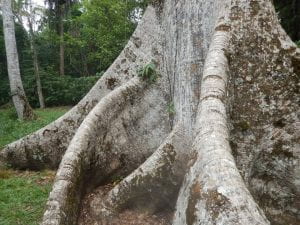On the way from the Crystal Paradise Ecolodge to the Chiquibul forest and Las Cuevas Research Station, we stopped in two different places: Rio on Pools (in the Mountain Pine Ridge) and the ruins of Caracol, and ancient Mayan city.
At Rio on Pools I took several pictures of trees that I want to identify when I get a chance (during daylight hours, when I can read the field guide). Of course, we saw the Caribbean Pine, which characterizes the Mountain Pine Ridge. For anyone reading this who does not know the regions of Belize, a ‘ridge’ is a description of a general area/ecosystem and not an actual landform of high elevation. I spent most of the time taking pictures, alternating between the trees and my classmates.

The Caracol experience was more notable in terms of learning about the region. The first time Scott came on this trip, he did not go to the ruins, but local people told him that it was entirely unreasonable to be this close to the ruins and not see them. The palace at the ruins of the ancient Maya city is the tallest building in Belize, and from the top (of course we climbed it!) you can see Guatemala. We learned quite extensively about the Maya for a few hours (religion, culture, social structures).

We also saw tons of trees. Our guide pointed out the Kapok or Ceiba tree (Ceiba pentandra) and the fluff that comes from the seed pods that I think he said was used as padding, for example in a mattress. The tree also has huge buttress roots extending from the sides that serve several purposes, including structural support and nutrient absorption. [insert picture here]

We also saw today:
A few more trees at the Maya site: Cohune palm (Attalea cohune), Fishtail palm (Chamaedorea sp.), more Trumpet tree (Cecropia peltata), relationship with guarding ant species, a Strangler fig (Ficus sp.), and some Montezuma Oropendolas (Psarocolius montezuma).

At Las Cuevas: a Cedar (Cedrela odorata), A Scarlet Macaw (Ara macao) and a Social Flycatcher (Myiozetetes similis).
We don’t have internet today because of the weather. It appears that the rainy season has started early this year. We will get to see how that effects the visibility of our focus species.
